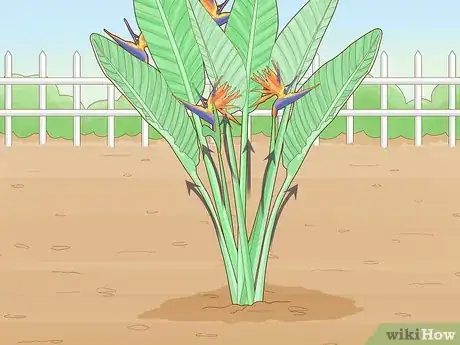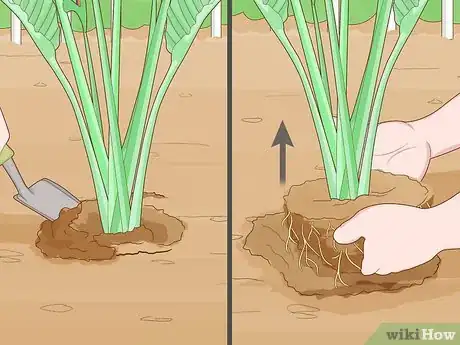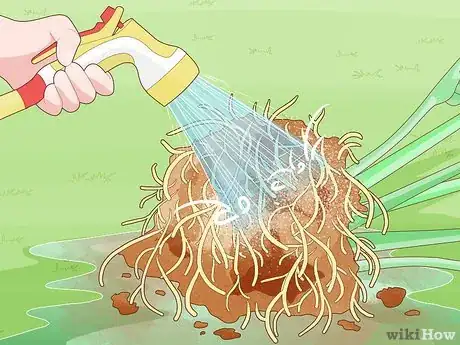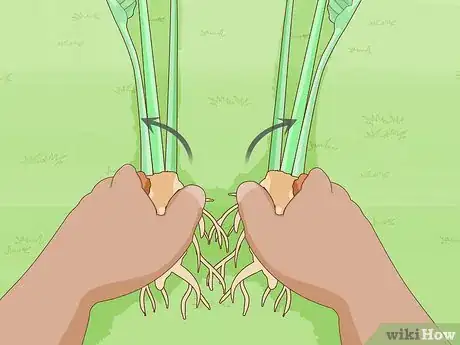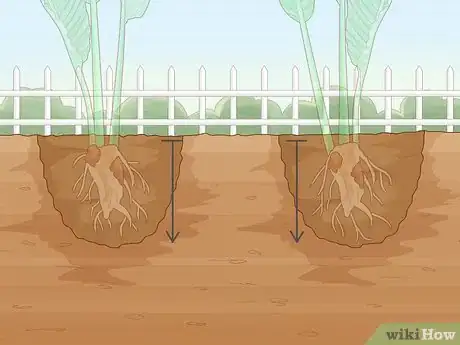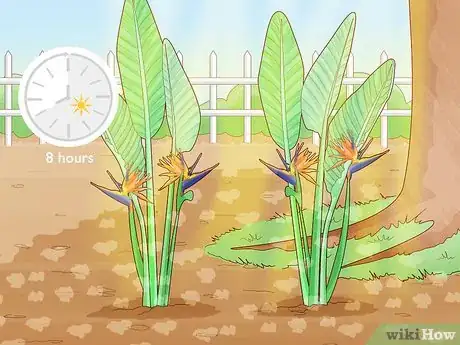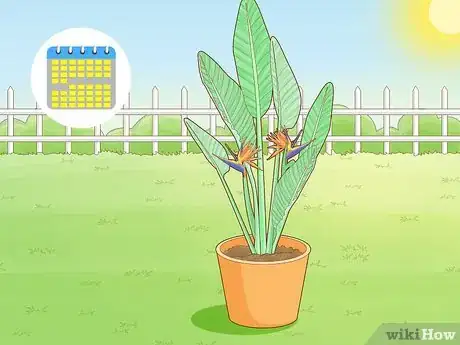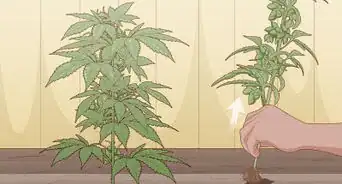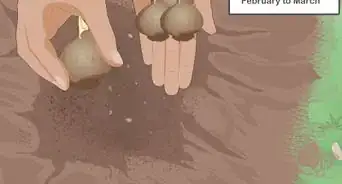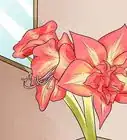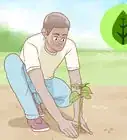This article was co-authored by Chai Saechao. Chai Saechao is the Founder and Owner of Plant Therapy, an indoor-plant store founded in 2018 based in San Francisco, California. As a self-described plant doctor, he believes in the therapeutic power of plants, hoping to keep sharing his love of plants with anyone willing to listen and learn.
This article has been viewed 52,340 times.
Birds of paradise are vibrant tropical flowers that grow best outdoors in hot, humid environments, but they can thrive if kept in pots as well. Divide a bird of paradise that has grown too big for its pot or that has lots of shoots coming out of its base. Start by breaking up the rhizome clumps at the base of the plants and then repot or replant them in well-draining soil. Take good care of the newly divided plants and you’ll have more beautiful bird of paradise flowers to enjoy within a few years.
Steps
Separating Rhizome Clumps
-
1
-
2Choose plants that have 6 or more stems. Check the base of the plants and look for one that has 6 or more stems going out from the base. You can divide these into individual plants which will then flower after 2-3 years.[2]
- You can get 6 separate divisions out of a clump that has 6 stems.
Advertisement -
3Dig or pull up plants with your hands and a garden trowel. Use your hands to remove a bird of paradise plant from a pot, or use a garden trowel to dig it up out of the ground. Turn the pot on its side, grasp the stems as close to the soil as possible and wiggle them back and forth as you hold onto the pot with your other hand.[3]
- This may be difficult to do if the plant is large or if it is root-bound in a pot, which means the roots are growing out through the holes in the bottom of the pot.
-
4Clean the roots by rinsing them with a hose. Lay the roots on a patch of grass or concrete and rinse them with a garden hose to get the soil off of them. You can also use your hands to pull large clumps of soil away from the roots. Keep rinsing and pulling away soil until all of the roots are visible.[4]
-
5Separate the roots with your fingers or a sharp, disinfected knife. Carefully disentangle the roots with your fingers and pull the stems apart. If the stems do not come apart easily, use a sharp, disinfected knife to cut them apart. Dip the knife into a cup of rubbing alcohol to disinfect it.[5]
- Ensure that each stem has a root attached to it. If the clump has 8 shoots, you should be able to get 8 divisions from it.
Warning: Be careful not to cut through the roots or stems. Cut between the stem clumps to divide them into smaller clumps with roots attached or single stems with a single root attached.
Repotting Divided Rhizomes
-
1Dig a hole deep enough to accommodate the entire root. Fill a small pot 1/3 of the way full of well-draining potting soil, and then use your hands to push the soil out towards the edges of the pot. You can also dig a new hole in your garden that is deep enough to accommodate the root.[6]
- Make sure that the pot you use has holes in the bottom of it so that any excess water will be able to drain out.
-
2Plant each stem in the pot or hole filled with potting soil. Position the stem and root in the soil so that they are at the same depth they were growing at before you dug the clumps up. Add more soil on top of the root and around the base of the stem.[7]
- If your soil is dense, add some sand to promote better drainage. Make a 3:1 mixture of soil and sand and use this as your potting soil.
Tip: You can also place polystyrene pieces or rocks in the bottom of your pot to help promote drainage.
-
3Water daily to keep the soil moist for the first 3-6 months. Never allow the soil to dry out completely after dividing and repotting or replanting a bird or paradise. Water it daily, and check the soil often to ensure that it stays moist. Your plant may require more water when the weather is dry or hot.[8]
- If you’re unsure about whether or not the soil is moist, stick your fingertip or a clean wooden popsicle stick into it by about 2 in (5.1 cm). If your fingertip or the wooden stick is dry when you pull it out, the soil is too dry.
-
4Place the plant in a spot with bright, indirect light. Birds of paradise require at least 8 hours of bright, indirect light. Don’t place the plants in direct, harsh sunlight for the first 8 weeks after you’ve divided them. Try placing the plant near a north or east-facing window so that the plant will get lots of bright morning sunlight.[9]
- Avoid south or west-facing windows as the light coming in may be too harsh.
-
5Keep the temperature in your home above 68 °F (20 °C). Check your thermostat regularly if you are keeping the plant indoors, or keep an eye on the temperatures outside if you’re keeping it outdoors. Bring the plant inside on cold days and nights if you’re growing it outside.[10]
- If you live in a cold climate, protect the newly repotted plant from drafts by placing it away from windows and doors.
-
6Move the plant to a sunny spot after 8 weeks. After 8 weeks, the bird of paradise can be in direct sunlight, so transfer it to a south or west-facing window to ensure that it gets 6-8 hours of bright sunlight. However, if the light is too harsh in these areas, keeping the plant in a north or east-facing window is also fine.[11]
- If you’re replanting the bird of paradise outside, make sure that it is not in the shade. Position it in your garden where it will get plenty of bright, direct sunlight during the day.
-
7Fertilize the plants after they have been growing for 3 months. Mix a 50% strength liquid fertilizer by combining half water and half fertilizer in a spray bottle. Apply the liquid to the base of the plant so it will permeate the roots—not the flowers, leaves, or stems. Do this after the newly divided plant has been growing for 3 months.[12]
- Check the manufacturer’s instructions for details on how to mix and apply the fertilizer.
Expert Q&A
Did you know you can get expert answers for this article?
Unlock expert answers by supporting wikiHow
-
QuestionIs it good to keep a bird of paradise plant inside?
 Chai SaechaoChai Saechao is the Founder and Owner of Plant Therapy, an indoor-plant store founded in 2018 based in San Francisco, California. As a self-described plant doctor, he believes in the therapeutic power of plants, hoping to keep sharing his love of plants with anyone willing to listen and learn.
Chai SaechaoChai Saechao is the Founder and Owner of Plant Therapy, an indoor-plant store founded in 2018 based in San Francisco, California. As a self-described plant doctor, he believes in the therapeutic power of plants, hoping to keep sharing his love of plants with anyone willing to listen and learn.
Plant Specialist
Things You’ll Need
- Garden trowel
- Gardening gloves
- Knife (optional)
- Rubbing alcohol (optional)
- Small pot or hole for each of the stems
- Potting soil
- Sand (optional)
- Polystyrene pieces (optional)
- Weak liquid fertilizer
References
- ↑ https://edis.ifas.ufl.edu/mg106
- ↑ https://edis.ifas.ufl.edu/mg106
- ↑ https://edis.ifas.ufl.edu/mg106
- ↑ https://hgic.clemson.edu/factsheet/bird-of-paradise/
- ↑ https://hgic.clemson.edu/factsheet/bird-of-paradise/
- ↑ https://edis.ifas.ufl.edu/mg106
- ↑ https://edis.ifas.ufl.edu/mg106
- ↑ https://www.bhg.com/gardening/plant-dictionary/perennial/bird-of-paradise/
- ↑ https://hgic.clemson.edu/factsheet/bird-of-paradise/

